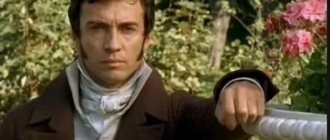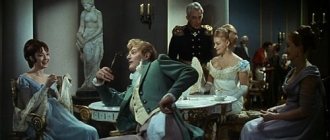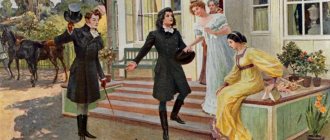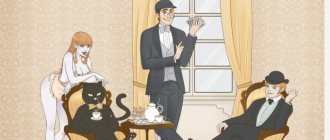- Essays
- On literature
- Tolstoy Lev
- Female images in the novel War and Peace
Lev Nikolaevich Tolstoy became a great writer of Russian literature. His works became known both in Russia and abroad. The most popular work, “War and Peace,” brought the author great fame. This novel became a discussion for critics who knew about Russia's war with Napoleon only by hearsay. Due to all the circumstances, Tolstoy wrote specifically what the people and he himself felt. Since the author himself lived in Rus', he glorified it in his works. He colorfully described nature, inhabitants and especially female persons. And this theme is undoubtedly of great importance in this novel.
Natasha Rostova
The main figure in the work is the dark-eyed and brave girl, Natalya Rostova. The author vividly described all her character traits and appearance, from a young age to her mature years.
The heroine, from childhood, was a desperate, open and courageous girl, of thin build. Due to the fact that the girl’s upbringing was not strict, she believed that she had practically conquered her whole life and the whole world. God gave her a gorgeous appearance, and the girl herself knew how to highlight it with her beautiful wardrobe. She had been developing manners and graceful gait since childhood, and when she walked down the street, many men secretly paid attention to her. A particularly striking moment in the novel, the writer expresses her walking down the street, wearing a light dress with lace edges. Besides that, girl. From an early age, she was a talented person, her desire to sing and dance, elevated Natalia in society. The main feature of the heroine is her self-confidence and inaccessibility.
Years later, Natalya's simple life is over, and one day at a ball, she meets a handsome gentleman. Without understanding her feelings, the girl confesses her love to Andrei Balkansky. This romance did not last long, and the girl, due to her age and inexperience, understands that this is not love, and looks at other men. Having attended the next ball, she succumbs to the influence of Anatoly Kuragin’s flirtation, and thereby ruins all relations with Bolkonsky.
All these actions begin to take place against the backdrop of the war with Napoleon, and this greatly strengthens the girl’s feelings and life. She becomes more patient and wiser. She no longer gives in to her fantasies and dreams. And in this difficult time, her fate brings her together with Andrei Bolkonsky. Real feelings of love washed over her, she understood that at that moment she had caused him enormous emotional pain. Bolkonsky himself was in serious condition. Natalya looked after him in every possible way, and understood that this was her true love, which she would soon lose. In the end, this happens, but this is not her last loss. The background of the war takes her brother and home from her. In desperate feelings, the girl becomes stronger in spirit and continues to live. On her life's journey, she meets a man with whom he understands that family and a loved one are the most precious things in a relationship. This person was Pierre Bezukhov. With him, Natalya becomes a typical family lady who no longer has those beautiful forms, she is not passionate about life. It was with this man that the girl grew into a strong woman. They both understood that being together was their happiness.
Minor heroines
Some of the girls depicted in the novel have many common features and are almost doubles. Thus, Andrei Bolkonsky’s wife and his sister’s companion are very similar, although they were born in different countries and social strata. Lisa and Mademoiselle Bourien are frivolous coquettes who focus only on the outer side of the world. They are beautiful, graceful, but empty inside. However, if a girl was unlucky with her appearance, she would go from a flighty coquette to an imaginary clever girl and talk only about lofty things, like, for example, Julie Karagina. In high society it was fashionable to imitate foreigners; the author showed this tendency using the example of Julie. She did not shine with beauty, but she tried to give herself the appearance of originality. She read, but did not understand, European authors, and simply retold their opinions in order to be considered wise. Other heroines are also associated with the motif of pretense. For example, Anna Drubetskaya also pretended, but in order to get her son a profitable job. She flattered, dissembled, and pleased, just to get her way. Anna Scherer also behaves artificially. Ostentatious patriotism, puritanical but unreal morality, fashionable but insincere opinions about politics—that’s her whole essence. Anna was a social weather vane, indicating the direction of the wind at court.
Having analyzed these images of women in the novel “War and Peace,” we can say that the author showed the most common types of female characters of that time. We ourselves see which qualities lead a girl to happiness and prosperity, and which ones deprive her of the opportunity to live honestly and morally. Family values, traditional foundations, kindness, responsiveness and sacrifice of character, a rich spiritual world, integrity and fortitude - these are what make a woman virtuous and happy. But greed, frivolity, imitation of fashion, insincerity, vanity, frivolity - all this destroys the good inclinations of a girl and turns her into a vicious woman, incapable of motherhood and marriage.
Author: Victoria Komarova
Marya Bolkonskaya
Another female character in this work is Marya Bolkonskaya. This is the complete opposite character from Natalia. This person is completely spiritually pure, loving all living things. Marya was a quiet and reserved figure in society. She had no social manners, and her fate was not easy. While raising her nephew, the girl looked after her old father. The hardships of life exhausted the heroine, but she held on with all her strength. The war greatly strengthened the character of the heroine, but unlike Natalya, she found true spiritual love, without ardent emotions and passions. Nikolai Rostov, that was the name of the man with whom fate brought Marya together. As a token of gratitude, fate gave her peace of mind. (More details)
Helen Kuragina
Undoubtedly, another female character appears in the novel, such as Helen Kuragina, Bezukhov’s husband. This is the difference between Natalya and Marya. In this character, the author incorporated feminine cunning, combined with luxurious clothes. Due to her status in society, the girl lives by rumors and doesn’t delve into much. Her betrayal of her husband is fraught with consequences, and she soon leaves for another world.
All three persons became the “filling” of the novel. Lev Nikolaevich tried to point out the ideal of a woman who could combine parts of these three heroines. Perhaps this is how he saw the ideal of a real Russian woman, with flirting, with feeling, and with experiences. (More details)
Essay Female images in the novel War and Peace by Tolstoy
L.N. Tolstoy wrote one of the most famous and unique creations of Russian literature; it touched on all the “eternal” aspects of existence: good and evil, love and hatred, honor and baseness. The author illuminates life, vividly describing all the contrasts and subtleties. In this epoch-making novel, Tolstoy creates a whole gallery of images. There are more than 550 heroes in the work and each has its own, exceptional character traits. To some, Tolstoy pays more attention and describes them more carefully, their joys and sorrows, ups and downs. The reader is exposed to many female images in the work. Tolstoy conveys exceptionally subtly and accurately the thoughts and feelings of the characters on the pages of the work.
Tolstoy was a master of depicting human souls. Therefore, I felt very subtly the psychology of young Natalya Rostova when she broke her doll, as well as the adult heroine when she lost her son. The reader sees all feelings and thoughts through the eyes of the characters. One of the brightest ladies' looks went to Natalia Rostova. Tolstoy combined exceptional character traits in the heroine, contrasting her nondescript appearance. He did not portray her as calculating and intelligent, soulless and adapted to fate, like another female character - Helen Kuragina. Natalya is simple and spiritual, which makes her more attractive than the beauty Helen, with her social manners and sharp mind.
The complete opposite of Natalya was Maria Bolkonskaya, she also does not have an attractive appearance, but does not evoke such warm feelings in the author, she is only good at gas, he says.
Also in the novel there are such images as Helen Kuragina and Julie Kuragina, these images are very similar to each other. Julie is a socialite, an enviable and rich bride of Russia, she received wealth after the death of her brothers. There is always a mask of well-being and steadfastness on her face. She is melancholic and seems disappointed in everything, she says that she has neither friendship nor love and that only “there” peace awaits her. Boris is very concerned about finding a bride with income, but he is also confident in her artificiality and feigned behavior.
Anna Pavlovna is one of the female images of the work. Her characteristic feature is stability in her actions, thoughts and behavior: “The restrained smile that constantly played on Anna Pavlovna’s face, although it did not match her outdated features, expressed, like spoiled children, the constant consciousness of her sweet shortcoming, from which she wants, cannot, does not find it necessary to get rid of it.” Behind such a description of the heroine, the author carefully hid his irony and hostility towards her.
L.N. Tolstoy depicts his ideal of a female image in his work. The ideal combines some of the traits of Maria and Natalia and even a bit of Helen Kuragina. The author’s priority is spirituality and sensitivity among human qualities. It is such a woman who can give harmony and happiness, despite the difficulties of life. Forgetting about the soul, creating a prosperous picture of existence, Tolstoy despises and sees in this the path leading to the abyss.
Female images in the novel “War and Peace” in the aspect of ecofeminist literary criticism
The subject of the article is the relationship between women and nature, women and men, men and nature in L. N. Tolstoy’s novel “War and Peace”. The female characters in the novel are examined, the close connection between women and nature is revealed in the light of ecofeminist literary criticism.
Key words: ecofeminism, L.N. Tolstoy, “War and Peace”, female images, nature.
The 20th century saw the rise of feminism and the environmental movement. What they have in common is that feminists hope to gain theoretical weapons and new theoretical perspectives, while environmentalists strive for more practical steps aimed at protecting nature. The combination of these two social forces created ecofeminism. The term was coined by French feminist scholar François de Oppony in her 1974 book Women or Death. De Opponi saw a commonality between women and the earth through their capacity for reproduction-fertility. She blamed patriarchal society for harming the environment and oppressing women.
Another ecofeminist advocate, Patrick D. Murphy, also calls for listening to the voices of women who advocate for the conservation of nature and culture. In general, ecofeminism examines environmental issues viewed from a gender perspective. The actualization of gender position is explained by the fact that a woman is closer to nature than a man. Women criticize androcentrism and anthropocentrism and oppose gender discrimination. By opposing various forms of domination and oppression, they are trying to restore a world in which people and nature are in harmony. Some ecofeminist ideas are related to the views of L. N. Tolstoy.
Chapter 1. Natural woman in “War and Peace”
According to representatives of ecofeminism, women and nature are responsible for preserving life on earth. They always sacrifice themselves. In addition, women are more active than men in demonstrating moral purity, sincerity and kindness. In the novel “War and Peace,” Tolstoy created several female characters: the impulsive, cheerful Natasha Rostova, the brilliant social beauty Helen Kuragina, the secretive quiet Sonechka, the shy, smart Marya Bolkonskaya, etc.
- Innocent Natasha
Natasha as a teenager is shown as a black-eyed girl with a big mouth. She's not beautiful. The friendly atmosphere of the Rostov family raised her to be cheerful, active and willful. Young Natasha does not understand the conventions of high society. She is pure jade, neither artificially carved nor contaminated by anything worldly. Andrei Bolkonsky calls her a person who does not bear the stigma of high society.
Natasha is close to nature. In the hunting scene with her uncle, she seems like a small animal in her native element. She loves horse riding and is interested in hunting. The Rostovs' neighbor, the landowner Ilagin, calls her Diana - the name of the ancient Greek goddess of the hunt and the animal world. Natasha truly belongs to nature. While visiting her uncle, Natasha quickly meets the village women. She loves country food and playing the balalaika. The climax is Natasha's performance of a Russian dance with a guitar. She “knew how to understand everything that was in Anisya, and in Anisya’s father, and in her aunt, and in her mother, and in every Russian person” [7].
In high society, Natasha's behavior looks contradictory. On the one hand, she loves to be looked at and wants to attract attention to herself. Natasha is upset when she is not invited to dance, but when she finds herself among the dancing couples, she feels joy again. On the other hand, among the prim aristocrats she looks like a stranger: “she knew what all this was supposed to represent, but it was all so pretentiously false and unnatural that she felt either ashamed of the actors or funny at them. She looked around her, at the faces of the spectators, looking for in them the same feeling of ridicule and bewilderment that was in her; but all the faces were attentive to what was happening on the stage and expressed feigned, as it seemed to Natasha, admiration” [2, p. 327]. Natasha is innocent and natural. She is observant. Noticing the ugliness of the actors, Natasha sees admiration on the faces of other spectators. This is how the heroine collides with the hypocrisy of high society.
2. Modest Marya
The daughter of Nikolai Andreevich Bolkonsky, Princess Marya, lives with her father in the village and leads an almost monastic life. Princess Marya's appearance differs from the appearance of Natasha Rostova: she has a thin face, she looks physically weak and unattractive. The only thing everyone notices about her appearance is her eyes: deep, radiant, calm and gentle. They allowed us to see her beautiful heart and pure soul. Whoever looked into those eyes immediately forgot about the girl’s external unattractiveness.
Princess Marya is kind and religious; in secret from her father, she receives “God’s people” in her house. The girl honors the Bible and its laws, based on love, mercy, patience, and universal harmony. In a letter to Julie Karagina, Princess Marya writes: “It only seems to me that Christian love for one’s neighbor, love for enemies, is more worthy, more gratifying and better than those feelings that the beautiful eyes of a young man can inspire in a young girl, poetic and loving, like you.” "[1, p.113]. Marya always treats other people with the greatest kindness: with tolerance towards her strange, stubborn father, takes care of her brother and pregnant daughter-in-law, takes care of her friend, because, in her opinion, this is happiness.
The Christian faith makes Princess Marya shrewd in assessing people. While others humiliate Pierre, seeing in him only the illegitimate son of Count Bezukhov, the heroine is able to appreciate Pierre's warmth. For her, kindness is the main quality of a person. When others envy Pierre, who inherited his father’s huge fortune, Princess Marya remarks: “I feel sorry for Prince Vasily and even more for Pierre. So young to be burdened with such a huge fortune - how many temptations will he have to go through! [1, p.114]. Princess Marya seems to foresee the dramatic events in Pierre's fate caused by his marriage to Helen Kuragina. If the aristocratic society led by Prince Vasily Kuragin values only nobility and wealth, then Marya Bolkonskaya well understands the severity of the burden of money. It is like a lake, whose calm, undisturbed surface reflects what is happening around.
3. Sad Helen
If Natasha Rostova and Princess Marya personify the spiritual beauty and charm of a woman, then Helen, the daughter of Prince Vasily, demonstrates a brilliant appearance: “Slightly rustling with her white ball gown, decorated with ivy and moss, and shining with the whiteness of her shoulders, the gloss of her hair and diamonds, she walked between men parted and straight, not looking at anyone, but smiling at everyone and as if kindly giving everyone the right to admire the beauty of their figure, full shoulders, very open, in the fashion of that time, chest and back, and as if bringing with them the splendor of the ball" [ 1, p.14].
Helen belongs to the category of women fascinated by the glitter of social life. Naturalness, sincerity, purity are not familiar to the secular beauty; their place has been taken by hypocrisy and greed. Helen cannot live without luxury, signs of attention, she is used to basking in the rays of her feminine glory, which men surrounded her with. The dream of wealth brought her closer to Pierre, but after marrying him, she did not become happier. Helen cheats on her husband, choosing her fans depending on their position in society and wealth. She, like a bird in a cage, rejoices in the convenience of this cage and does not notice that she has lost the ability to fly and is deprived of communication with nature. Despite her brilliant appearance, Helen's heart remains empty, and her tragic fate is predetermined.
Chapter 2. Common things in nature and women
For thousands of years, men have been realizing their power intentions, oppressing women, and exploiting nature. Environmental feminist Greta Gard argues that the oppression of nature and women is based on the same ideology - the dual antagonism of male centralism and anthropocentrism. Women and nature, included in the system of male dominance, are objectified, moving into the category of “others”. The novel “War and Peace,” which mainly depicts the life of representatives of noble society, shows the destruction of the world due to war and the oppression of women in Tsarist Russia.
- Humanity and nature
Nature is the source of life, our common home with plants and animals. Meanwhile, in the process of history, anthropocentrism prevailed, elevating man above nature. Man has become the absolute master of the world, turning nature into an object of plunder. A male society that encourages the desire for power, wealth, fame, separated people from nature: “People stop cutting each other, and this event is accompanied by a justification consisting in the need for unity of power, resistance to Europe, etc. People go from west to east, killing their own kind” [4, p.320]. In the fire of war, nature turned from the parent of humanity into an arena of the struggle for power and global carnage: “... on this hot August day, the same body filled the dirty pond along the Smolensk road” [3, p.256]. Tens of thousands of corpses, dressed in military uniforms from different countries, lay in the fields and meadows, there was blood on the grass and dirt everywhere.
On the battlefield, life is devalued, nature is desecrated, vegetation is destroyed, animals are driven out, peasants are deprived of their homes. The harmony of life is being destroyed: “Clouds gathered and rain began to fall on the dead, on the wounded, on the frightened and exhausted, and on the doubting people. It was as if he was saying: “Enough, enough, people. Stop it... Come to your senses. What are you doing?” [3, p.263]. Rain is the tears of nature, which mourns the incalculable loss of life. Nature mourns for humanity, plunged into the abyss of disasters and suffering, but it is unable to correct the situation. Nature suffers the fate of a victim, to which she is doomed by the ruthless world of male ambitions, which has unleashed a war.
2. Man and woman
In the novel, Tolstoy subjects high society to merciless criticism. Despite the fact that the country is in danger, representatives of the nobility continue to weave intrigues, fight for power, and lead riotous and immoral lives. Prince Andrei understands that such a life is far from his ideals. He admits to Pierre that the high society drawing room, where gossip, intrigue, and petty vanity reign, forms a labyrinth from which he cannot get out. This dictated his desire to go to war, where, as it seems to him, he will find himself.
But fate left no choice for grand ducal women like Helen: they were born and raised in a social environment from which there is no escape. The fate of noble ladies is to be accessories to men; their inner world is almost poorer than the world of commoners. The life of aristocrats passes in secular drawing rooms, and not in nature, which they do not know and do not feel. The task of noble ladies is to please men, exchanging their love and beauty for a family union, which is highly valued in a patriarchal society. After receiving an inheritance, weak-willed Pierre gained honor and respect in aristocratic circles. Poor relative Sonya, who lives with the Rostovs out of mercy, is deprived of the opportunity to marry her beloved Nikolai. And although Prince Andrei is inclined to reproach women for selfishness, vanity, mental underdevelopment and spiritual emptiness, he does not understand that these shortcomings are the result of the patriarchal model of society imposed on them, where the social role of women is distorted.
The feudal system of gender relations impedes the spiritual development of women, and war, being the work of men, interferes with the world of women. The family happiness of Lisa Bolkonskaya is destroyed. A young pregnant woman is imprisoned in a village under the supervision of her wayward father-in-law. She never has time to see her husband or care for the newborn child. The war forces Countess Rostova to send two sons to the front; the death of the youngest of them, Petya, plunges her into despair, causing her to develop mental illness. War means not only dead men, but also women who have lost their husbands, brothers, sons - unhappy widows, mothers, sisters. The war deals a heavy blow to their tormented souls. Women are powerless to resist the war, just as Lisa is powerless to restrain her husband or Countess Rostov is powerless to restrain her sons. This expresses the injustice and cruelty of a world ruled by men.
Chapter 3. Natural powers of a woman
Women are naturally endowed with special protective mechanisms that allow them to remain active and mentally active in extreme conditions. They can remain sincere and kind, as well as resist fate and continue the process of internal self-development.
- The power of female self-healing
Living in the estate with her father before the war, Princess Marya did not experience any difficulties. His death was a heavy blow for her. At the same time, the shackles of her father's power, which had shackled her daughter for ten years, were broken, and Princess Marya was forced to build her own life. Love for Nikolenka saved her from grief. She refused the offer to take refuge in France, because France was responsible for the death of her father and the destruction of her homeland. Princess Marya concentrated her mental and physical strength on raising her nephew. Misfortune did not break her, teaching her to resist circumstances.
Unlike Princess Marya, Natasha was under the protection of her large and friendly family. Only when the family was forced to leave Moscow to avoid being occupied did Natasha face a cruel reality. A severe test for her was a meeting with the seriously wounded Prince Andrei. Seeing the mark of death on his face, she looks after him like a faithful nurse, tormented by the fact that she cannot alleviate his suffering. Another blow for Natasha was the death of Petya, her younger brother. But her mother’s grief forced her to maintain her mental strength. Natasha surrounded her with care and love, trying to heal the wounds caused by the war.
- The power of women in difficult situations
We are witnessing the amazing transformation of Princess Marya. When she again appeared before Nikolai, “for the first time all that pure spiritual, inner work with which she had lived until now came out. All her inner work, dissatisfied with herself, her suffering, the desire for good, humility, love, self-sacrifice - all this now shone in those radiant eyes, in her thin smile, in every feature of her gentle face” [4, 24]. Having lost her brother, Princess Marya devoted herself to raising his little son, Nikolenka Bolkonsky, and this devoted love could not but evoke a response in the heart of Nikolai Rostov.
Moral tests also changed Natasha Rostova. Not a trace remained of the former gaiety and playfulness. Her gaze became melancholy, her soul became responsive and tolerant. Pierre didn't even recognize her right away when they met again. Natasha, who has matured, has retained her childhood innocence and feminine elegance. Now she will not allow herself to be deceived by mistaking a man’s external attractiveness for his moral essence. She appreciates the warmth of the relationship and the kinship of souls that connect her with Pierre. After Natasha married Pierre, she devoted herself to her husband, children, family, realizing her feminine destiny.
In “War and Peace” L.N. Tolstoy creates the images of Natasha Rostova and Princess Marya, revealing their rich inner world and spiritual beauty. In contrast to them, the image of the cold secular beauty Helen is shown. The author describes female beauty, notes women's closeness to nature, and condemns discrimination against women in aristocratic society. At the same time, Tolstoy reveals the harsh truth of the war, depicting the heroism and tragedy of the Russian people. Thus, Tolstoy expressed his desire to return to nature, to create a world in which men, women and nature are in harmony.
Despite the fact that Tolstoy’s idea of a woman’s purpose is limited to the family sphere, his depiction of female characters and destinies in “War and Peace” allows us to draw the following conclusion: the writer appreciates a kind, mentally developed, natural woman, capable of self-healing and self-development in difficult situations.
Literature:
- Bugovich V. Some aspects of the interpretation of novel images of L. N. Tolstoy (the image of Natasha Rostova in the novel War and Peace) // Humanitarian space. -2012. -No. 2. -P.391–406.
- Introduction to gender studies: textbook. manual for university students / edited. ed. I. V. Kostikova. 2nd ed., revised. and additional M.: Aspect Press, 2005. 235 p.
- Volkova V. B. Man and nature in L. N. Tolstoy’s novel “War and Peace.” dis. Ph.D. Phil. Sciences / V. B. Legonkova. - Magnitogorsk, 2002. -174 p.
- Gulin Alexander. The ideal female image in Russian epic prose of the 19th century. Masha Mironova and Natasha Rostova // Russian literature. -2019.-No. 6.-P.71–80.
- Petukhova T. V. L. N. Tolstoy and his followers on the role of women in public life // Problems of socio-economic, political and cultural development of Russia. Interuniversity collection of scientific works. -Ulyanovsk: Ulyanovsk State Technical University, -2015. -P.57–62.
- Streltsova A. S. Man-nature-society in the philosophical system of L. N. Tolstoy // L. N. Tolstoy and Russian domestic thought about national education, collection of scientific works based on the materials of the International Scientific-Practical Conference. -Orekhovo-Zuevo: State University of Humanities and Technology, -2016. -P.259–266.
- Tolstoy L.N. War and Peace. T. 1–2: novel in 4 volumes. M.: Fiction, 1937–1940. 1916 p.
- Yuryeva O. Yu., Wang Lanju. Female images in L. N. Tolstoy’s novel “War and Peace” in the light of the ideas of Chinese philosophy // Kazan Science. 2021. No. 10. pp. 56–59.








